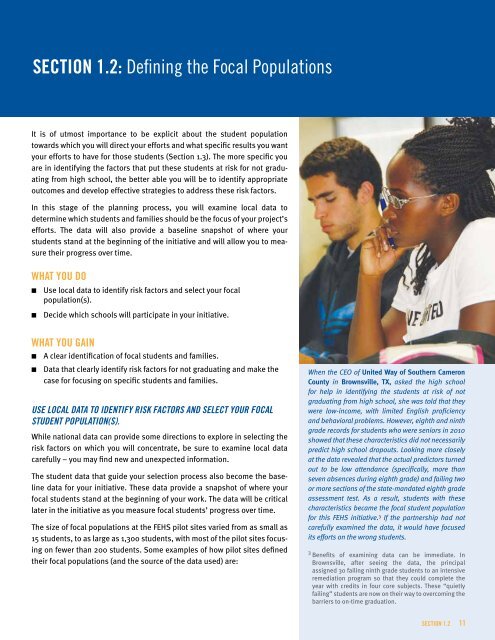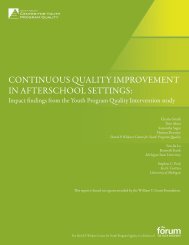View PDF
View PDF
View PDF
- No tags were found...
You also want an ePaper? Increase the reach of your titles
YUMPU automatically turns print PDFs into web optimized ePapers that Google loves.
Section 1.2: Defining the Focal PopulationsIt is of utmost importance to be explicit about the student populationtowards which you will direct your efforts and what specific results you wantyour efforts to have for those students (Section 1.3). The more specific youare in identifying the factors that put these students at risk for not graduatingfrom high school, the better able you will be to identify appropriateoutcomes and develop effective strategies to address these risk factors.In this stage of the planning process, you will examine local data todetermine which students and families should be the focus of your project’sefforts. The data will also provide a baseline snapshot of where yourstudents stand at the beginning of the initiative and will allow you to measuretheir progress over time.What You Do■■Use local data to identify risk factors and select your focalpopulation(s).■■Decide which schools will participate in your initiative.What You Gain■■A clear identification of focal students and families.■■Data that clearly identify risk factors for not graduating and make thecase for focusing on specific students and families.Use local data to identify risk factors and select your focalstudent population(s).While national data can provide some directions to explore in selecting therisk factors on which you will concentrate, be sure to examine local datacarefully – you may find new and unexpected information.The student data that guide your selection process also become the baselinedata for your initiative. These data provide a snapshot of where yourfocal students stand at the beginning of your work. The data will be criticallater in the initiative as you measure focal students’ progress over time.The size of focal populations at the FEHS pilot sites varied from as small as15 students, to as large as 1,300 students, with most of the pilot sites focusingon fewer than 200 students. Some examples of how pilot sites definedtheir focal populations (and the source of the data used) are:When the CEO of United Way of Southern CameronCounty in Brownsville, TX, asked the high schoolfor help in identifying the students at risk of notgraduating from high school, she was told that theywere low-income, with limited English proficiencyand behavioral problems. However, eighth and ninthgrade records for students who were seniors in 2010showed that these characteristics did not necessarilypredict high school dropouts. Looking more closelyat the data revealed that the actual predictors turnedout to be low attendance (specifically, more thanseven absences during eighth grade) and failing twoor more sections of the state-mandated eighth gradeassessment test. As a result, students with thesecharacteristics became the focal student populationfor this FEHS initiative. 3 If the partnership had notcarefully examined the data, it would have focusedits efforts on the wrong students.3 Benefits of examining data can be immediate. InBrownsville, after seeing the data, the principalassigned 30 failing ninth grade students to an intensiveremediation program so that they could complete theyear with credits in four core subjects. These “quietlyfailing” students are now on their way to overcoming thebarriers to on-time graduation.SECTION 1.1 1.2 11








